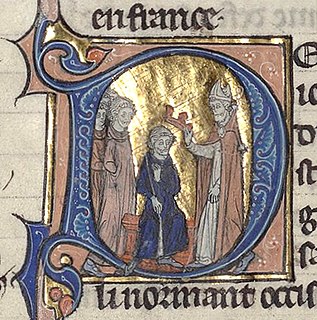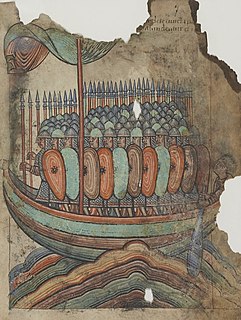The 880s decade ran from January 1, 880, to December 31, 889.

Year 889 (DCCCLXXXIX) was a common year starting on Wednesday of the Julian calendar.

Year 888 (DCCCLXXXVIII) was a leap year starting on Monday of the Julian calendar.

The Duchy of Brittany was a medieval feudal state that existed between approximately 939 and 1547. Its territory covered the northwestern peninsula of Europe, bordered by the Atlantic Ocean on the west, the English Channel to the north. It was less definitively bordered by the Loire River to the south, and Normandy and other French provinces to the east. The Duchy was established after the expulsion of Viking armies from the region around 939. The Duchy, in the 10th and 11th centuries, was politically unstable, with the dukes holding only limited power outside their own personal lands. The Duchy had mixed relationships with the neighbouring Duchy of Normandy, sometimes allying itself with Normandy, and at other times, such as the Breton-Norman War, entering into open conflict.
Wrhwant, Gurwant, Gurwent or Gurvand was a claimant to the Duchy of Brittany from 874 until his death in opposition to Pascweten, Count of Vannes.
Alan I, called the Great, was the Count of Vannes and Duke of Brittany from 876 until his death. He was probably also the only King of Brittany to hold that title by a grant of the Emperor.

Alan II, nicknamed Wrybeard or Twistedbeard, Alan Varvek in Breton, was Count of Vannes, Poher, and Nantes, and Duke of Brittany from 938 to his death. He was the grandson of King Alan the Great by Alan's daughter and her husband Mathuedoï I, Count of Poher. He expelled the Vikings/Norsemen from Brittany after an occupation that lasted from 907 to about 939.

Geoffrey I, Duke of Brittany, also known as Geoffrey of Rennes and Geoffrey Berengar, was the eldest son of Duke Conan I of Brittany. He was Count of Rennes, by right of succession. In 992 he assumed the title of Duke of Brittany, which had long been an independent state, but he had little control over much of Lower Brittany.

Odo of Rennes, Count of Penthièvre, was the youngest of the three sons of Duke Geoffrey I of Brittany and Hawise of Normandy, daughter of Richard I of Normandy. Eudon married Agnes of Cornouaille, the daughter of Alan Canhiart, Count of Cornouaille and sister of Hoel II, Duke of Brittany who was married in 1066 to Eudon's niece Hawise, Duchess of Brittany.
Conan I nicknamed Le Tort was the Duke of Brittany from 990 to his death.
Judicael or Judicaël is a Breton masculine given name. It may refer to:
Berengar II was the Count of Bayeux and Rennes and Margrave of the Breton March from 886 until his death a decade later.
The counts of Nantes were originally the Frankish rulers of the Nantais under the Carolingians and eventually a capital city of the Duchy of Brittany. Their county served as a march against the Bretons of the Vannetais. Carolingian rulers would sometimes attack Brittany through the region of the Vannetais, making Nantes a strategic asset. In the mid-ninth century, the county finally fell to the Bretons and the title became a subsidiary title of the Breton rulers. The control of the title by the Breton dukes figured prominently in the history of the duchy. The County of Nantes was given to Hoel, a disinherited son of a duke. He lost the countship due to a popular uprising. That uprising presented an opportunity for King Henry II of England to attack the Breton duke. In the treaty ending their conflicts, the Breton duke awarded the county to Henry II.
The Count of Rennes was originally the ruler of the Romano-Frankish civitas of Rennes. From the middle of the ninth century these counts were Bretons with close ties to the Duchy of Brittany, which they often vied to rule. From 990 the Counts of Rennes were usually Dukes of Brittany. In 1203 the county was integrated into the ducal demesne. The Count of Rennes was a title held by the House of Rennes.
Count of Vannes was the title held by the rulers of the County of Vannes.

The Kingdom of Brittany was a short-lived vassal-state of the Frankish Empire that emerged during the Norseman invasions. Its history begins in 851 with Erispoe's claim to kingship. In 856, Erispoe was murdered and succeeded by his cousin Salomon.

The Battle of Trans-la-Fôret was fought on 1 August 939 between the occupying Norsemen and the Bretons, led by the joint army of Alan II, Hugh II of Maine, and Judicael Berengar.
Hugh II, Count of Maine, son of Hugh I, Count of Maine, and an unknown mother, probably a daughter of Gauzlin II, Count of Maine. He was, like his father, a vassal of his uncle Hugh the Great.

Viking Brittany refers to the Viking occupation of Brittany during the High Middle Ages. Throughout the 9th century, the Bretons faced threats from various flanks: they resisted full incorporation into the Frankish Carolingian Empire yet they also had to repel an emerging threat of the new duchy of Normandy on their eastern border by these Scandinavian colonists.